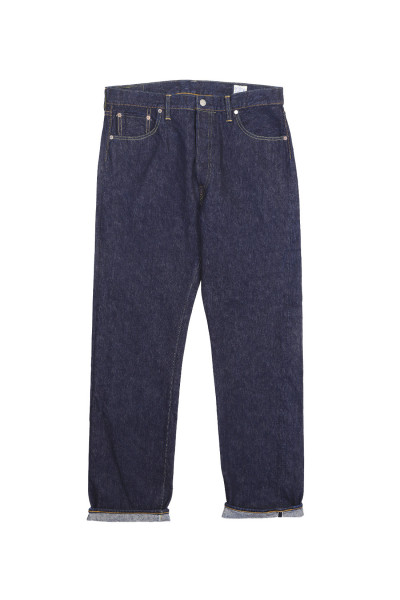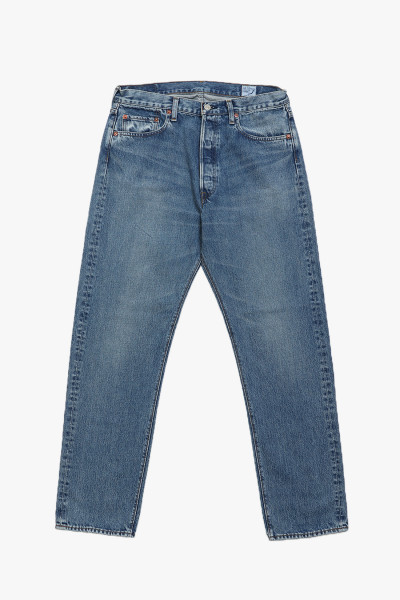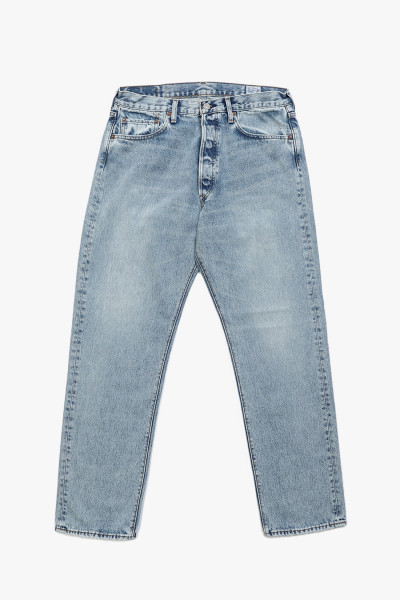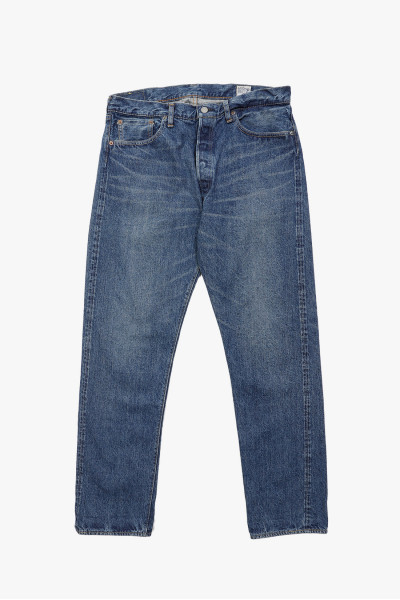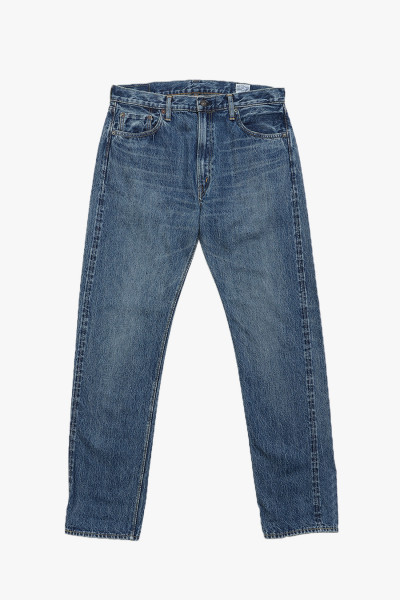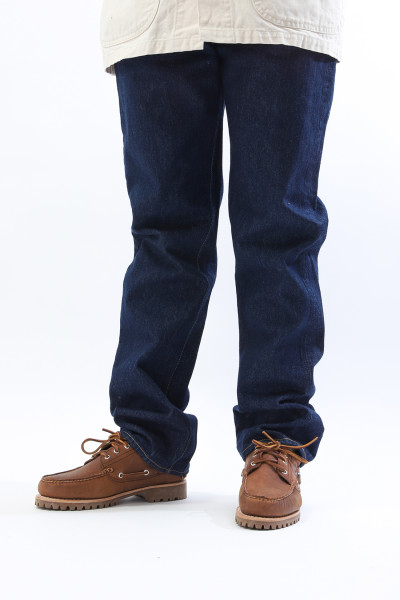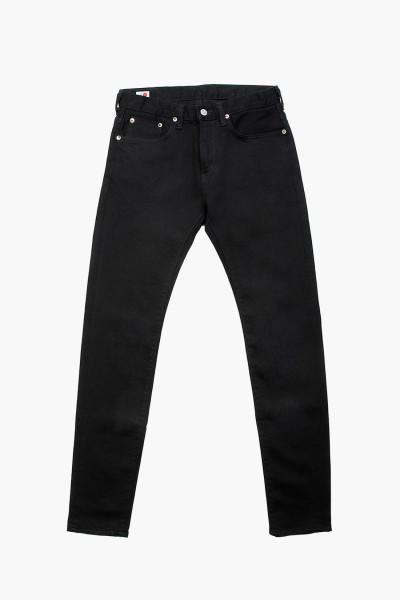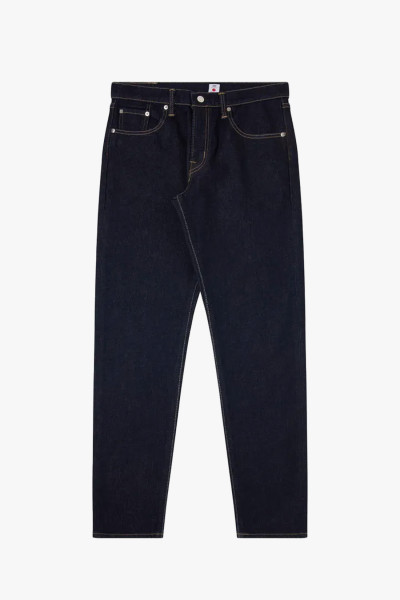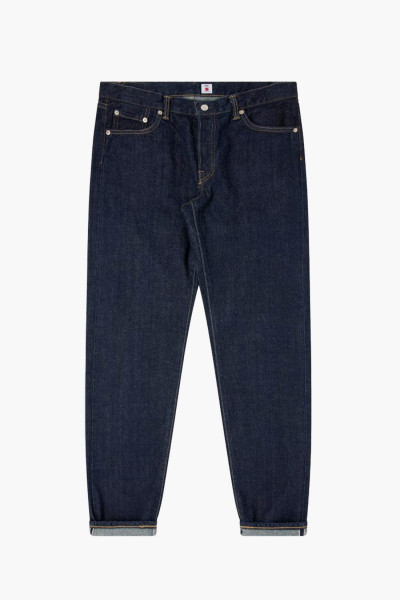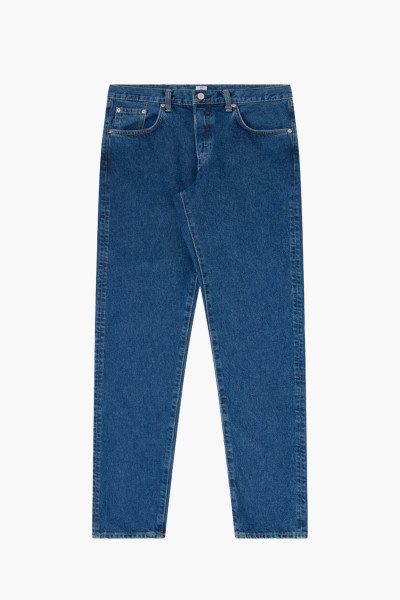Japanese Denim
Everything you need to know about Japanese denim
In just a few short years, the archipelago has become the world's center for denim. But why are Japanese jeans so coveted?
After World War II, jeans were introduced to the archipelago by American soldiers. Quickly becoming popular, manufacturers in Okayama, specifically Kojima City, with suitable looms, began to produce jeans locally, giving birth to a new denim industry.
Like other denim-producing countries, Japan has experienced ups and downs over the decades, with productivity gains often at the expense of their excellence. Some companies then decided to refurbish their old machines, beginning a true return to their roots, to the golden age of denim. With labels such as Pure Blue Japan, Oni or Momotaro, local denim has gradually regained its former prestige. It will then be renamed the "selvedge". The machines used and the methods employed for its manufacture remain the same as in the past, in accordance with the Japanese craft tradition.
What are selvedge jeans? Word for word the translation gives something like "selvedge denim". Basically, it's the little detail that makes all the difference. The one that aficionados like to show off by doing the little hem that goes well. The Selvedge is the natural and clean outer seam that does not fray, does not unravel, in short it is the one that makes your pants stronger! And the secret of this excellence lies in the manufacturing process thanks to traditional shuttle looms. They weave a continuous thread (the weft) that is passed back and forth along the length of the roll to create a return loop on the natural edge of the fabric. That's the famous border visible along the outer seam.
.
To make one pair of Selvedge jeans, you need about eight feet of fabric, and that's no small amount! To avoid waste, manufacturers use all the fabric, even the ends. And where it gets cool is that the selvedge edge is sewn with a colored thread, often red. This way, the weaver can distinguish the gathered fabrics. How clever is that?
Contrary to popular belief, jeans from the archipelago are mainly made on local machines and not on machines imported from the United States. For the record, Sakichi Toyoda invented the archipelago's first power loom in the late 19th century, which revolutionized the country's textile industry. In 1918, he founded the Toyoda Spinning & Weaving Company and with the help of his son Kiichiro, they created their first automated machine in 1924. Two years later, he established Toyoda Automatic Loom Works. It was through the sale of his automated loom patent for £100,000 that Kiichiro founded the Toyota Motor Corporation in 1937.
In the 50's, denim manufacturers modernized their production by replacing their shuttle machines with faster and wider projectile machines, allowing mass production and global distribution of their jeans. But denim has also evolved in terms of dyeing techniques. Initially dyed with natural indigo, a blue substance produced by the fermentation of the leaves of the indigo tree, the Nipponese started looking for a more resistant indigo dye that washes out easily on cotton, which gave the technique "rope dyeing". This method consists in immersing the threads in several baths of natural indigo alternating with oxidation baths. Curiously, the indigo appears green before turning blue in contact with oxygen. The successive layers of indigo create a unique jean that will naturally fade more quickly than a more deeply dyed jean. Some also play with the natural color of cotton to achieve unique fades, like Naked & Famous' Dirty Fade Selvedge.
The different weaving techniques
Shuttle machines allow for different kinds of patterns, such as the classic right hand twill, left hand twill, broken twill, slubby, neppy, and many more. With these different weaving techniques, it is possible to create canvases with a wide variety of textures and looks, which will patina differently depending on the weaving method used.
.
The thickness of the fabric
In denim we play with the weight of the canvas to get lighter or heavier jeans. This information is often listed in ounces "oz" on product sheets and is an important criterion to consider when choosing your jeans. Generally, the standard weight is about 14.5 oz, but some labels, like Orslow, have offered fabric ranging from 5 oz to 32 oz!
Fabrication details
High-end denim manufacturers still opt to use vintage machines such as American Union Special sewing machines, known for their strong chain-stitch seams. In addition, they use copper rivets to reinforce the tension points. For the more discerning enthusiast, the details are even more subtle, such as the presence of "peek-a-boo" on the pocket of the piece or hidden rivets for the back pockets. For vintage purists, these are the kind of details that make all the difference!
The Finishes
Using selvedge fabric, different finishes can be achieved for jeans:Raw: the fabrics are woven and the jeans are sewn together without any additional treatment, although most selvedge is sanforized to pre-shrink them while retaining its raw look. One wash: the fabric is washed once by the manufacturer to set the fit of the jeans and make the fabric more flexible. Tempi: a technique of washing in cold water followed by drying in the sun to pre-shrink the fabric while preserving its rough feel. Unsanforized: a fabric that shrinks noticeably in the first wash and is very stiff and rough, but offers exceptional fading and a perfect fit after several months of wear. It is advisable to take a size up for this type of fabric. The production of selvedge fabric is more expensive, but it provides a quality incomparable to that of standard jeans. The machines and skilled craftsmen to use them are rare and are mainly concentrated in the Okayama area.
.
Choosing the right Japanese jeans for you
It's hard to plan when buying online, so this mini guide should help you understand the basics of the subject and help you better choose your jeans without making a mistake. Although we are talking about Japanese denim, the following information can be useful in choosing any cut of jeans. Choosing your jeans may seem simple, but in practice, each brand has its own cut names and aesthetic references, which can make finding the ideal cut difficult. On top of that, you have to take into account your own body type and shape, which can make choosing a pair of jeans particularly complex. Fortunately, certain criteria such as the weight, the treatment of the fabric and the manufacturing details can help to refine the choice. It's important to take the time to understand these criteria and learn about the brand before making your final choice. At Graduate, we specialize in denim sales and are always available to help you find the perfect jeans for you.
Let's start with the basics
Choosing the right jeans can be difficult, even if they're a basic garment. Before embarking on a search for the perfect jeans on our product sheets, it's important to understand the fit terms related to the pants. Once you have mastered these terms, it will be easier to choose the right fit for your body type and personal style.
Jeans cuts in a few words
When it comes to choosing a jean cut, we can divide it into two blocks: the fullness at the thigh, which goes from the top of the jeans to the crotch, and the fullness at the leg, which can be more or less tapered and refers to the tightening of the leg up to the ankle, also called "taper" in English.
A straight jean (straight) will have a thigh fullness equal to or nearly equal to its leg fullness, while a tapered jean will have a leg fullness less than its thigh fullness. Waist height is also an important criterion, which can be highrise, natural or mid-rise, and low-rise, with the front-rise determining the height of the jeans. It is recommended to choose a Japanese jean with a front-rise as long as possible for a better comfort. The measurements to remember to accurately characterize the fit of a pair of jeans are the waist width (waist), thigh width (thigh), front rise and back rise height, inseam length (inseam), outseam length (outseam) and leg opening (leg opening).
.
Knowing these criteria and one's own body type is essential to choosing jeans properly, because the rendering of the same cut can vary according to body type. By taking the measurements of a pair of pants that already fit you well, you can choose your jeans more serenely and increase your chances of getting the desired rendering. For example, for a Japanese jean, it is advisable to choose an overall length long enough for an original fit if you are tall enough.
It's also important not to fall into the cliché of baggy clothes for Asians and tight fits for Westerners. The Japanese brands that export their denims do produce narrower cuts for Europeans, and their passion for the product drives them to reproduce every conceivable variation in this area. It is important to remember that size differences play an important role. The cut of a wide jean on a person measuring 1m70 will not give the same rendering on a person of 1m90 and 25 kilos more.
What is the peculiarity of cut names in the Japanese denim world?
The Western system
Let's start with what we are most likely to understand. The American and European houses that we usually come across more commonly often restrict themselves to a single adjective to describe a cut, for example: loose or straight These names refer to both the thigh or the leg, or both at the same time. Cut names such as "cigarette" or "carrot" are more precise, but can also refer to several different realities depending on the brand that uses it. In short, the Western system is not the most accurate when it comes to making your choice from a distance.
The Japanese system
Much more fun once you get the hang of it! Unlike Westerners, the Nipponese are much more meticulous and very often use two designations to specify their cuts, for example Loose + Tapered
This system defines both thigh fullness and leg fullness.The first comes to define the thigh fullness: Wide, Loose, Relaxed, Regular, Tight, and the second, on the other hand, defines the leg line: Straight or Tapered. In terms of equivalence, a cut called "semi-slim" in Europe can correspond to a regular tapered or tight tapered on the island. A so-called "carrot" cut, on the other hand, can range from wide tapered to loose...
The different cuts of Japanese denim
You will have understood, the system of the archipelago is more logical than our names of cuts that mean everything and nothing at the same time. To make it easier for you we'll still divide the cups into 3 families like good westerners.
The "Straight"
It is important to understand that in the context of Japanese jeans, a straight cut does not necessarily mean a wide cut. As said before a straight cut with the adjective "straight" in the second position determines the difference between the fullness of the thigh and the leg is minimal and it is the first adjective that comes to vary the cut. Therefore, a "tight straight" jean is not impossible. We will have a cut that starts with very little fullness at the thigh, but which will keep a straight line to the end of the leg. On the other hand, a pair of Japanese jeans designated only as "straight" indicates a fairly wide, vintage cut that is not tapered.
The "Tapered"
In contrast to the straight cut, tapered are characterized by a gradual reduction in leg fullness after the thigh, creating a tapered effect pointing toward the ankle. The intensity of the taper depends on the initial fullness of the thigh, with a wide thigh resulting in less taper and a narrow thigh resulting in more taper. In short, the tapered cut creates a cone effect that tapers toward the ankle and the intensity of this tightening depends on the initial fullness of the thigh.
The Slim, Skinny or "Tight"
This third category doesn't really differ from the last ones, as these cuts can also be slim or tight. Since the Western market is already saturated with skinny jeans, a Japanese tight jean is unlikely to be better than an American one, except perhaps in the quality of the fabric. Opting for a Japanese-style slim fit can be risky. If you are in the western standards, it is likely that the cut is a little short, so it is advisable to look carefully at the length or ask us for the measurements. Small specification, Japanese brands use the term "tight" to refer to skinny jeans that can be much narrower than a basic slim.
Which cut of jeans to choose?
You should now have a better grasp of how the denim market works in the Asian archipelago. Here's the time to make your basket. So, how do you choose your jeans from this selection?
The importance of body type
The choice of the cut of jeans adapted to your morphology is fundamental. Each brand may target a different type of person, so it's important to choose a fit that suits you based on your physical characteristics, such as leg length, thigh size and calf size. The measurements we have seen together above will allow you to imagine how the jeans will look on you rather than on a mannequin that is not representative of most people. However, it is not recommended to choose a cut based on general rules such as "if you have wide thighs, choose this cut". The most appropriate approach is to think in terms of the silhouette. It's important to consider all parameters when choosing your denim cut, even if it means having more than one. If you want to show off your body, you can choose the cut that best suits you according to current standards that promote fit. However, if you're thinking in terms of silhouette with a specific style goal in mind, you'll need to choose a more particular cut that will better suit your outfit, even if it's not necessarily the "optimal" fit for your body type.
Over-sizing your Japanese cut
The concept of "size-up" is an additional thought about the silhouette, which can be especially important when talking about Japanese jeans. Basically, "size-up" is taking a pair of jeans one or two sizes up, which translates into an increase in width at the waist to have more fullness throughout (and more length if necessary). In general, a size-up allows the jeans to be worn lower on the hips, especially if they are high waisted. However, the author does not recommend doing this at first if you don't know exactly what you want, especially with expensive jeans. It's easy to want to "distort" a cut of jeans or pants, trying to turn a slightly tight fit into a loose fit (or vice versa), but this can be a bad idea. It's important not to force things and choose a cut that suits your body type and style, without trying to artificially transform it.
The made in Japan from Edwin
Edwin is one of the archipelago brands to have established American jeans in Japan. The brand would go on to create one revolution after another by developing the "Old Wash" wash, which aims to reproduce the look of previously worn jeans. It is also at the origin of the "new vintage" denim concept, which seeks to recreate in a handmade way the best washes of the first collections. A force for constant innovation and authenticity, EDWIN is now a leader in the denim industry.
Now marketed internationally Edwin presents its made-in-Japan denim collection with a simplified naming system. Dropping the ED numbering structure and replacing it with a clear and descriptive style-based naming system, they have developed a 5-pocket selection that focuses on classic cuts, and their bestseller. This concise denim selection now includes the Loose Straight, Loose Tapered, Regular Tapered, Tight Tapered and Skinny cuts, which replace the ED-39, 45, 55, 80 and 85 respectively.
.
The brand uses premium textiles from iconic fabric mills, honoring their origins and the craftsmanship that has developed over the past six decades. These include Nihon Menpu, Kaihara, Kurabo and Kuroki, which then give their names to five key styles. These styles are offered in a wide range of selvage denims, specialty fabrics and recycled fibers, all available in different weights and applied washes. All jeans are then produced, processed and finished in Japan.
.
For Edwin one of the main reasons for switching to Japanese production is of course sustainability, not only to offset carbon emissions through better global logistics, but also through the addition of lightweight, recyclable buttons and rivets, as well as new 90% pulp paper labeling, which replaces the old leather branding. Washing techniques have also been improved with waterless bleaching techniques, laser technology and environmentally friendly methods wherever possible.
The iconic Orslow Denim
Orslow is a Japanese brand that makes denim made to last. A clever blend of Japanese expertise and the American military universe the brand is based on the mantra "Do well and do better every day". To do this it produces sparingly and thoughtfully to ensure a high-end garment that is both timeless and modern.
Orslow is the art of the basic with incomparable comfort. Modernity at the service of the classic. In their workshop in Hyogo, Japan, the manufacturing process begins with the making of the threads. The production of an Orslow is limited: although the machines run night and day, the output is very slow, which does not allow large production.
Orslow created a line of denim that is now a benchmark, the straight-cut Orslow 105 and the more fitted Orslow 107. Orslow was inspired directly from the Levi's archives, specifically, Big E's personal collection (original Levi's until 1971). As a premium denim brand, Orslow is very committed to vintage manufacturing. Each weave comes straight out of a 1930's shuttle machine, with a consistently perfect result. Compare an original 70's jean to the Orslow 107, you won't see any difference, the cotton looks like it's straight out of the history books.
To take things a step further, here are some articles on Japanese denim:
What is Japanese denim?
Welcome to the authentic world of Japanese selvedge denim, its history and origins. Understand the difference between selvedge and raw denim, then delve into the manufacturing process of this exceptional fabric. Explore why it's so popular, and learn how to spot a fake.

